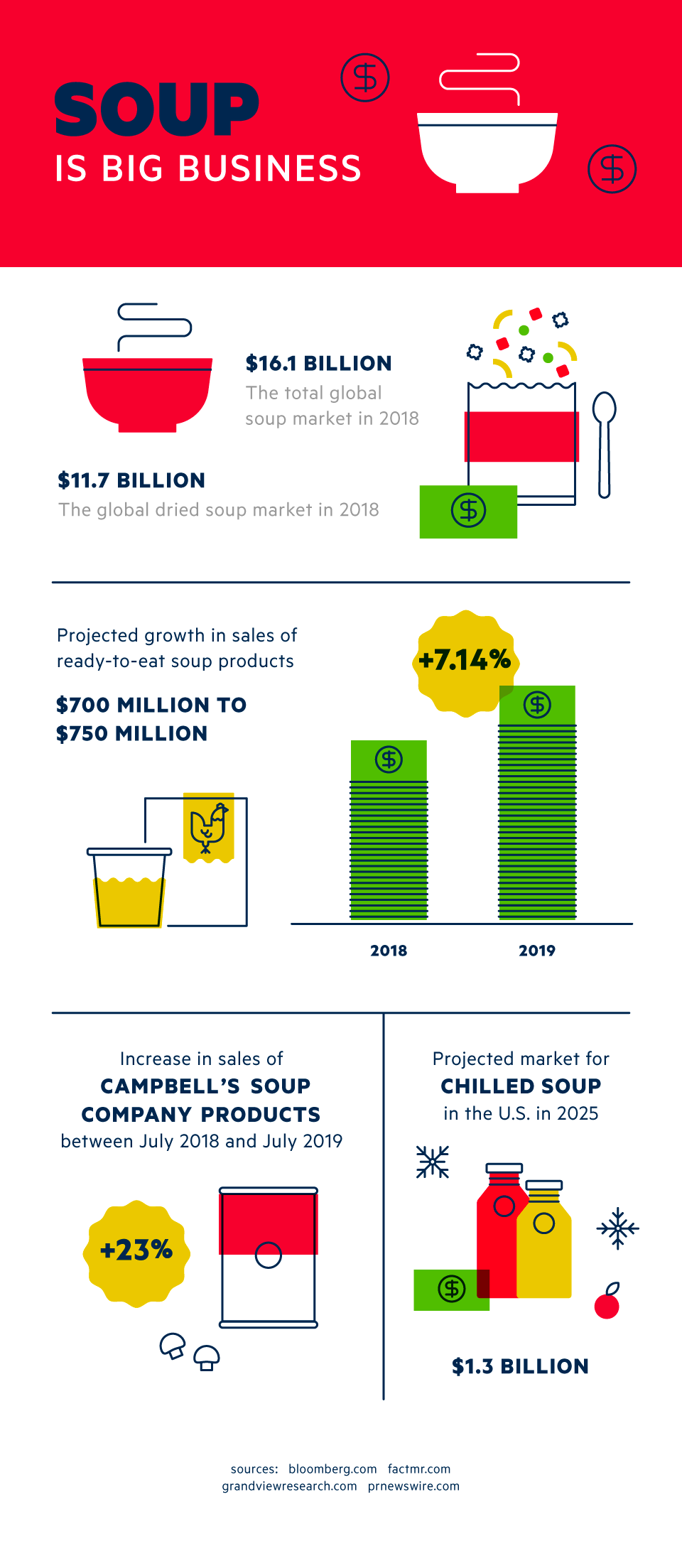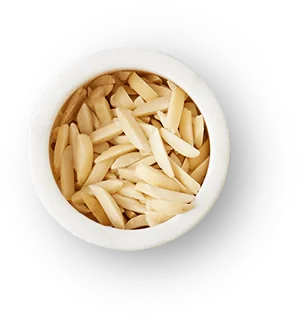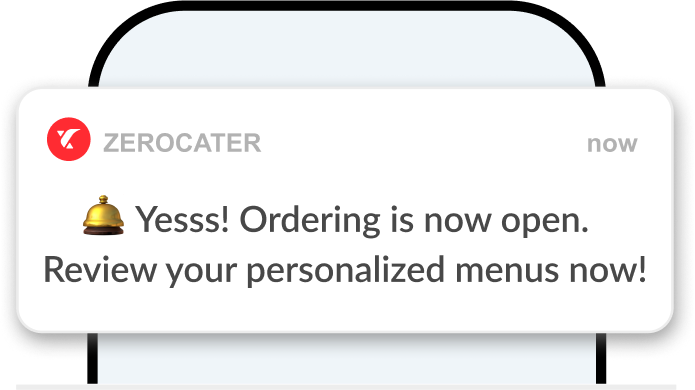Soup: It’s what’s for lunch, dinner, and more.
The global soup market exceeded $16 billion in 2018, and market experts predict it will continue to grow. Campbell Soup Company alone saw 2019 sales increase 23 percent over 2018.
More Americans are turning to soup for meals and snacks, but they don’t necessarily want a traditional hot, steaming bowl of salty, meaty soup anymore. Modern soup fans expect diversity in soup, from ingredients to global cuisines, from nutritional profiles to sustainable sourcing. Here are some soup trends to get your soup spoon ready for.

Drinkable soups
Brands such as Whole Foods expect soups to go from the bowl to the commuter cup. Where grab-and-go snacks have long been crunchy or crispy treats, trends watchers expect fresh, ready-to-eat, drinkable soups to hit big in 2020.
You could compare drinkable soup to a thick, savory smoothie or a smooth gazpacho. Many popular styles are packed with nutrients and made with whole, often plant-based ingredients. Manufacturers package them in cartons or bottles, and you can enjoy them hot or cold. They make a filling meal, and they help you hydrate, which may be welcome on days when you’re too busy to grab a healthy beverage.
Another plus of drinkable soups? Along with being convenient and flavorful, many drinkable soups are low in sugar and rich in fiber. And if you don’t want to chug soup on the go, you can pour it in a bowl for a sit-down meal.
Dried soups
Sometimes you want soup at work but can’t bust out a soup pot or access a fridge full of fresh ingredients in the office break room. That’s one of the reasons dried soups have become an unsung hero of the soup world.
Whether air-dried or frozen, vegetarian or meat-based, or sealed in a cup or a pouch, the best dried soups are made with whole, cooked, and dried ingredients. Lightweight, easy to store, and fast to prepare, dried soups offer big convenience in a small package. And they’re easy to store in bulk, even at your desk.
Dried soups can contain a variety of ingredients: legumes, meat, vegetables, grains, seasonings, salt, and more. With nearly $10 billion in revenues in 2018, dried soup is one of the most popular styles of soup. Some varieties are high in sodium and preservatives, but soup makers are looking at ways to make their products healthier and lower in salt.
One thing’s for sure: It’s hard to beat the convenience of dried soup. Stow a few packets in your bag, at the office, and elsewhere. Add hot water and enjoy.
Plant-forward soups
While they’re not necessarily vegan or vegetarian, an increasingly popular soup trend puts a focus on vegetables, grains, and legumes. Veggies are the stars of these soups, stews, and chilis, which start with a vegetable-broth or bone-broth base, but they may also include other animal-based ingredients such as egg noodles, cheese, or cream.
More American workers are shifting toward plant-heavy food offerings for their office lunches. Soup makers are responding by upping their uses of plant-based ingredients and adding less meat and animal products or leaving them out entirely.
Soup is an easy, tasty way to eat more vegetables, whole grains, and pulses (including beans, peas, lentils, chickpeas, and edamame). That doesn’t mean health-conscious soup-lovers can’t enjoy meats or other animal products if they wish. Some plant-forward soups contain beef, chicken, sausage, or other meats.

Vegan soups
If you prefer only plant-based ingredients, many food makers make vegan soups with rich flavor and a healthy amount of protein. They don’t include any animal products (even honey or gelatin).
Caramelized, smoked, or roasted vegetables make a tasty base for rich, savory, long-simmered stocks. Global palates of seasonings amp up flavor and aroma. And many plants make excellent, bio-available protein sources in soup, such as:
- Quinoa
- Chickpeas
- Spinach
- Almonds
- Kale
- Cashews
- Avocados
- Lentils
Especially trending now? Look for gazpacho, tomato, butternut squash, and broccoli with vegan cheese. More cooks are also taking a fresh look at entree menus and developing vegan soups from dishes such as eggplant Parmesan.
Soup makers increasingly offer vegan soups that not only boast flavor and nutritional density but also provide convenience and portability. Look for ready-to-eat vegan soups in ready-to-eat or microwave-friendly packaging. They’re a delicious way to pack more plants into your busy workdays.

Healthier soups
As you may have noticed, a meta-trend underlying many of the latest soup trends is not just more convenient packaged soups but healthier soups in general. Where some soup brands rely on excess salt and preservatives, more soup makers are filling consumer demands for (and bowls with) low-sodium soups with fewer artificial ingredients or preservatives.
Consumers want convenience, but many aren’t willing to trade health benefits for it. Fresh, ready-to-eat, whole-food soups offer both expediency and nutrition. After all, soups are a natural, nourishing, soul-soothing way to pack in protein, vitamins, minerals, and other nutrients.
Overall, three out of five Americans think many packaged soups are too processed. As more brands make their ingredients transparent and healthier, odds are their sales will get more robust too.
Soups aren’t just healthy for the person but for the planet too. Homemade soups are a great way to help Americans reduce food waste. Imperfect ingredients are perfect for the soup pot, where you can simmer or puree them for maximum flavor and zero-waste cooking.
Noodle soups
Noodle soups are popular the world over, whether they’re Italian-style pasta soups such as minestrone, Vietnamese rice noodle-based pho, or Japanese buckwheat soba ramen. And they’re gaining popularity in the United States.
The cuisines of East and Southeast Asia are driving a tangy, spicy broth of soup innovation. With Vietnamese cuisine growing in popularity, Americans are peering beyond pho for other distinctive, flavorful Vietnamese soups such as bun bo hue, which features rice vermicelli and beef.
Japanese-style ramen is also rising in popularity in the U.S. Ramen fans line up to slurp up the rich Japanese noodle soups in major American cities such as New York, Chicago, San Francisco, Washington, D.C., and Los Angeles.
With their growing appetite for global cuisines, Americans are innovating a classic: chicken noodle soup. If a culture has noodles and chicken, odds are it has a chicken noodle soup whether it’s Persian, Italian, Thai, Slavic, or Puerto Rican. And Americans are hungry to try new varieties.
No matter how you like your seasonings or noodles, noodle soups are the ultimate hunger-quencher and soul-soother, and they’re perfect for a busy workday.
Chilled soups
While a bowl of steaming noodle soup can be soothing, hot soup doesn’t always sound good. On a blazing summer day, the thought of something hot is as appealing as a snow cone in winter. And sometimes you’re in a hurry and want a nutritious, filling meal but don’t want to take time to heat soup.
Chilled soups are coming to your rescue. You don’t need to heat these soups to enjoy them. While chilled soups are meant to be cold, the market for them is heating up. In 2017 alone, Panera’s refrigerated soups streamed past $100 million in sales in grocery stores. From $790 million worldwide in 2017, experts anticipate the chilled soup market to hit $1.3 billion in the U.S. alone by the end of 2025.
And we’re not just talking about classics such as gazpacho or vichyssoise (a chilled potato soup). Popular modern chilled soups include sweet corn, summer squash, yogurt, avocado, watermelon, cucumber — and even beet-based borscht.
Like other trending soups and soup styles, soup makers offer chilled soups with convenience and on-the-go eating in mind. Instead of bowls, more soup makers are packaging chilled soups in bottles. Keeping consumer health concerns in mind, many makers also keep sugar and salt levels low and pack in nutrients, including fiber, from whole foods. It’ll be easier to find those chilled soups: Grocers are stocking more chilled soups so that you can stock up too.
Conclusion
Whether hot or cold, on the go, or at your desk, anytime is a good time for soup. A diverse array of soup is gaining popularity nationwide. Next time you’re hungry, reach for a bowl—or a carton or bottle—of your favorite soup.
 to plan your catering
to plan your catering

